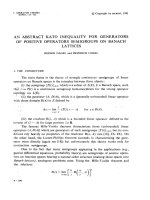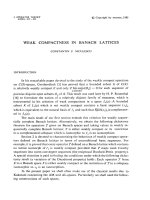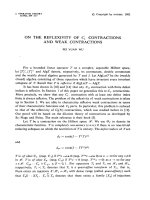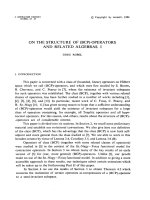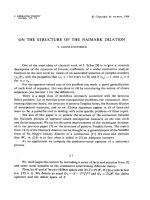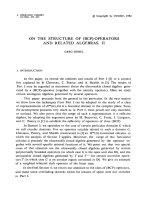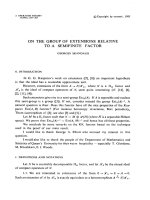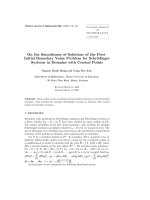Báo cáo toán học: "Coloring the edges of a random graph without a monochromatic giant component" doc
Bạn đang xem bản rút gọn của tài liệu. Xem và tải ngay bản đầy đủ của tài liệu tại đây (112.65 KB, 7 trang )
Coloring the edges of a random graph
without a monochromatic giant component
∗
Reto Sp¨ohel
†
Institute of Theoretical Computer Science
ETH Z¨urich, Switzerland
Angelika Steger
Institute of Theoretical Computer Science
ETH Z¨urich, Switzerland
Henning Thomas
‡
Institute of Theoretical Computer Science
ETH Z¨urich, Switzerland
Submitted: Mar 25, 2010; Accepted: Sep 19, 2010; Published: Oct 5, 2010
Mathematics Subject Classification: 05C80, 05C15
Abstract
We study the followin g two problems: i) Given a random graph G
n,m
(a graph
drawn uniformly at random fr om all graphs on n vertices with exactly m edges),
can we color its edges with r colors such that no color class contains a component
of size Θ(n)? ii) Given a random graph G
n,m
with a random partition of its edge
set into sets of size r, can we color its edges with r colors subject to the restriction
that every color is used for exactly one edge in every set of the partition such that
no color class contains a component of size Θ(n)?
We prove that for any fixed r 2, in both settings the (sharp) threshold for the
existence of such a coloring coincides with the known threshold f or r-orientability
of G
n,m
, which is at m = rc
∗
r
n f or some analytically computable constant c
∗
r
. The
fact that the two problems have the same threshold is in contrast with known results
for the two corresponding Achlioptas-type problems.
1 Introduction
One of the most prominent areas of research in random graph theory is the component
structure of the random graph G
n,m
(a graph drawn uniformly at random from all graphs
∗
A preliminary version of this paper appeared in the proceedings of the European Conference on
Combinatorics, Graph Theory and Applicatio ns (EuroComb) 2009 [17].
†
The author was supported by the Swiss National Science Foundation, grant 200020-119918. He is
now at MPI Saarbr¨ucken.
‡
The author was supported by the Swiss National Science Foundation, grant 200021-120284.
the electronic journal of combinatorics 17 (2010), #R133 1
on n vertices with exactly m edges). In their seminal 1960 paper, Erd˝os and Rnyi [10]
discovered that an abrupt ‘phase transition’ occurs at m = n/2. We say that an event
occurs asymptotically almost surely (a.a.s.) if it occurs with probability tending to 1 as n
tends to infinity. For the sake of readability, we omit ceiling and floor signs whenever they
are not essential. In particular, we write G
n,m
where technically we should write G
n,⌊m⌋
(or G
n,⌈m⌉
) since m(n) is not necessarily an integer.
Theorem 1 ([10]) For any co nstant c > 0 the following holds .
• If c < 0.5, then a.a.s. all components of G
n,cn
have O(log n) vertices.
• If c > 0.5, th e n a.a.s. G
n,cn
contains one co mponent with Θ(n) v e rtice s , and all
other componen ts have O(log n) vertices.
We can also think of this result in the setting of a random graph process where random
edges are inserted one by one into an initially empty graph. Then the theorem states that
a.a.s. a linear-sized ‘giant component’ emerges quite precisely at the point where the
average degree in the graph is 1. In the past decades, much research has been devoted to
more detailed studies of the behaviour of the random graph (process) around this critical
point; see [7, 14] for an overview of results.
A direction of research that has appeared more recently in the literature concerns the
question whether the emergence of a giant component can be postponed or accelerated
if some freedom of choice is introduced in the setup. The most prominent model of
this type is the so-called Achlioptas process, in which two random edges are sampled at
each step, and one of them has to be selected to be included in the graph. Note that
this is an online model in which we are required to select edges before we have seen the
entire random graph. As it turns out, the emergence of a giant component can be both
accelerated or slowed down by a constant factor if appropriate edge selection strategies
are used [2, 4, 6, 12, 16]. However, no threshold result similar to Theorem 1 is known for
this or other online scenarios.
Motivated by this line of research, Bohman and Kim [5] studied a similar question in
an offline setting. Given cn pairs of random edges, can we select one edge from each pair
to obtain a graph with cn edges that does not contain a giant component? If we assume
that all edges are sampled without replacement, then drawing cn random edge pairs is
equivalent to drawing 2cn random edges and partitioning these into pairs uniformly at
random. More generally, we denote for any fixed integer r 2 by G
r
n,m
a random r-
matched graph obtained by generating a random graph G
n,m
and partitioning its edge
set into sets of size r uniformly at random (where we assume w.l.o.g. that m is divisible
by r). Throughout, we call these r-sets and denote them by E
j
, 1 j m/r. We say
that a subgraph is an Achlio ptas subgraph of G
r
n,m
if it contains exactly one edge from
each r-set.
In this terminology, the result of Bohman and Kim reads as follows.
Theorem 2 ([5]) There exists an analytically computable constant c
1
≈ 0.9768 such that
for any constan t c > 0 the following holds.
the electronic journal of combinatorics 17 (2010), #R133 2
• If c < c
1
, then a.a.s. G
2
n,2cn
has an Achlio ptas subgraph (with cn edges) all compo-
nents of which have O(n
1−ε
) vertices, where ε > 0 is a constant depending o n c.
• If c > c
1
, then a.a.s. every Achl i optas subgraph of G
2
n,2cn
contains a compo nent with
Θ(n) vertices.
A similar but less restrictive scenario was investigated earlier by Bohman, Frieze, and
Wormald [4]. Given an ordinary random graph G
n,2cn
, can we select cn edges such that
the resulting graph does not contain a giant component? As it turns out, the threshold
for this property is slightly higher than the one stated in Theorem 2.
Theorem 3 ([4]) There exists an analytically computable constant c
2
≈ 0.9793 such that
for any constan t c > 0 the following holds.
• If c < c
2
, then a.a.s . G
n,2cn
has a subgraph with cn edges all components of which
have O(1) vertices.
• If c > c
2
, then a.a.s. every subgraph of G
n,2cn
with cn edges contains a componen t
with Θ(n) vertices.
In this paper we consider analogous questions for two Ramsey-type settings. In the
first we are given a random graph G
n,m
and are required to color its edges with a fixed
number r of available colors. Our goal is to avoid a monochromatic giant component in
each of the r color classes. Note that, by the pigeon-hole principle, Theorem 3 yields an
upper bound for the case r = 2.
The second setting we investigate is more restrictive and motivated by Theorem 2.
We call an r-edge-coloring of the random r-matched graph G
r
n,m
valid if every color is
used for exactly one edge from every r-set. Note that that this implies in particular that
every color class has the same size. Our goal now is to find a valid r-edge-coloring of G
r
n,m
such that no color class contains a giant component. Note that, again by the pigeon-hole
principle, Theorem 2 yields an upper bound for the case r = 2 in this more restricted
setting that is slightly better than the bound given by Theorem 3 for the first setting.
As it turns out (see Theorem 4 below), the thresholds of these two Ramsey settings
coincide, in contrast to what happens for the edge-selection scenarios studied in Theorem 2
and Theorem 3. In order to state our main result, we need to introduce one more notion.
For any integer r 2, a graph G is called r-orientable if there exists an orientation of its
edges such that the in-degree of every vertex is at most r. Cain, Sanders, and Wormald [8]
and independently Fernholz and Ramachandran [11] showed that the property that G
n,m
is r-orientable has a sharp threshold at m = rc
∗
r
n for some analytically computable
constant c
∗
r
. In [8] the following numerical values are stated: c
∗
2
≈ 0.897, c
∗
3
≈ 0.959,
c
∗
4
≈ 0.980, and c
∗
5
≈ 0.989.
Our result is the following.
Theorem 4 For every integer r 2, le t c
∗
r
denote the constant which determines the
threshold for r-orientability of the random gra ph G
n,rcn
. Th en for any constant c > 0 the
following holds.
the electronic journal of combinatorics 17 (2010), #R133 3
• If c < c
∗
r
, then a.a.s. there ex i s ts a valid r-edge-coloring of G
r
n,rcn
in which all
monochromatic components hav e O(n
1−ε
) vertices, where ε > 0 i s a constant de-
pending on c and r.
• If c > c
∗
r
, then a.a.s. every r-edge-coloring of G
n,rcn
contains a monochromatic
component w i th Θ(n) vertices.
Note that the first statement of the theorem is about the restricted setting and the sec-
ond statement is about the unrestricted setting. Together they imply that the thresholds
of both scenarios coincide.
The threshold for the unrestricted setting was also derived independently from us by
Bohman, Frieze, Krivelevich, Loh, and Sudakov [3]. They also investigated the corre-
sponding online setting, where random edges appear one by one and have to be colored
immediately with one of r available colors, and the version of the problem where the goal
is to create monochromatic giants instead of avoiding them.
Let us conclude this introduction by stating an open question we would like to see
answered: What is the threshold for the property that the v ertices of a random graph
can be colored in such a way that no color class induces a linear-sized component? It is
not hard to see that for any c > 1.5, a random 3-vertex-coloring of G
n,cn
yields a giant
component a.a.s. On the other hand, Achlioptas and Molloy [1] showed that a.a.s. G
n,cn
can be properly 3-colored as long as c < 1.923, thus providing a significantly better lower
bound than a random vertex-coloring.
2 Proof of Theorem 4
2.1 Preliminaries
We state two results which we will need in our proofs. The following density lemma is a
straightforward generalisation of Lemma 2 in [4].
Lemma 5 ([4]) Le t c > 0. For every ε > 0 there exists δ = δ(c, ε) > 0 such that a.a.s.
the random graph G := G
n,cn
has the property that f or every S ⊆ V (G) for which G[S]
contains more th an (1 + ε)|S| edges w e have |S| δn.
The following lemma conveniently sums up the arguments given in Section 4 of [5].
Lemma 6 ([5]) Le t c > 0. For every δ > 0 there exists ε = ε(c, δ) > 0 such that a.a.s.
the random graph G := G
n,cn
has the property that for every subgraph H ⊆ G in whic h all
components are trees or unicyclic, a.a.s. the graph obtained by removing min{δn, e(H)}
edges uniformly at random from H has only components with O(n
1−ε
) vertices.
the electronic journal of combinatorics 17 (2010), #R133 4
2.2 Upper bound proof for unrestricted setting
Let c > c
∗
r
. We need to show that a.a.s. every r-edge-coloring of G
n,rcn
contains a
monochromatic component of linear size.
In [8, 11] it was shown that m = rc
∗
r
n – the threshold for r-orientability of G
n,m
–
coincides with the threshold for the property that the (r + 1)-core of G
n,m
has average
degree at most 2r (the k-core of a graph G is the maximal subgraph of G with minimum
degree at least k). For some details, see the introduction of [11]. It is known [15] that
a.a.s. the (r + 1)-core of G
n,rc
∗
r
n
has linear size, which implies by a standard two-round
exposure argument that for c > c
∗
r
, there exists ε > 0 such that a.a.s. the (r +1)-core C
r+1
of G
n,rcn
has average degree at least (1 + ε)2r, i.e., satisfies
|E(C
r+1
)| (1 + ε)r|V (C
r+1
)| .
(For explicit statements about the number of vertices and edges in cores of random graphs
see [9, 13]). By averaging, a.a.s. in every r-edge-coloring of G
n,rcn
there exists a monochro-
matic connected subgraph H ⊆ C
r+1
with at least (1 +ε)|V (H)| edges. By Lemma 5 such
a subgraph is a.a.s. of linear size.
2.3 Lower bound proof for restricted setting
Let c < c
∗
r
. We need to show that a.a.s. we can find a valid r-edge-coloring of G
r
n,rcn
in
which every monochromatic component is of size O(n
1−ε
) for some constant ε which only
depends on c and r.
Similarly to the proof of Theorem 2 in [5], we generate G
r
n,rcn
by first generating a
slightly denser random r-matched graph G
+
and then removing a few r-sets uniformly at
random. Let δ = δ(c, r) > 0 such that c + δ < c
∗
r
, and let G
+
:= G
r
n,r(c+δ)n
be a random r-
matched graph with r-sets E
1
, . . . , E
(c+δ)n
. We let G denote the r-matched graph obtained
by removing δn r-sets chosen uniformly at random from G
+
. Note that, by symmetry, G
is distributed exactly as G
r
n,rcn
. Thus if we can show that a.a.s. there is a valid r -edge-
coloring of G
+
in which all monochromatic components are trees or unicyclic, the lower
bound part of Theorem 4 immediately follows by applying Lemma 6 (with c ← r(c + δ)
and δ ← δ) in each color class and taking a union bound over all r color classes.
Recall that m = rc
∗
r
n is the threshold for r-orientability of the random graph G
n,m
.
Hence, by our choice of c, a.a.s. there exists an orientation of the underlying unmatched
graph of G
+
in which every vertex has in-degree at most r. Conditioning on this and
considering a fixed such orientation d, we now look for a partition of G
+
into r edge-
disjoint Achlioptas subgraphs such that in every color the in-degree of every vertex is at
most 1. Note that every edge e ∈ E(G
+
) is oriented towards exactly one vertex and is
contained in exactly one of the r-sets E
1
, . . . , E
(c+δ)n
. This naturally defines a bipartite
multigraph B with parts V (G
+
) and {E
1
, . . . , E
(c+δ)n
} in which every edge of G
+
induces
an edge connecting the vertex it is oriented towards with the r-set it is contained in
(see Figure 1 for an example). Clearly, every r-set E
j
has degree exactly r in B, and,
since d is an r-orientation of G
+
, every vertex v ∈ V (G
+
) has degree at most r in B.
the electronic journal of combinatorics 17 (2010), #R133 5
2
1
5
3 4
1
2
3
4
5
G
+
B
Figure 1: Example for the construction of the multigraph B (r = 2). The sets E
1
, . . . , E
5
are indicated by different types of lines.
Hence, the maximum degree in B is r. It is well known (as Hall’s theorem implies that
an r-regular bipartite (multi)graph can be partitioned into r perfect matchings) that the
chromatic index of a bipartite graph equals its maximum degree. Hence there exists a
proper r-edge-coloring c
B
: E(B) → {1, . . . , r} of B. Since c
B
is proper, the subsets
P
+
1
, . . . , P
+
r
⊆ E(G
+
) corresponding to the color classes of c
B
form a partition of G
+
into
r edge-disjoint Achlioptas subgraphs such that the in-degree of every vertex in each of
the parts is at most 1. This implies that for 1 i r every component in P
+
i
is a tree or
unicyclic since a connected graph with two cycles has edge-density strictly larger than 1
and is thus not 1-orientable. Thus we have found a valid r-edge-coloring of G
+
(with color
classes P
+
1
, . . . , P
+
r
) in which every monochromatic component is a tree or unicyclic, and
Lemma 6 can be used to complete the proof as outlined above.
References
[1] D. Achlioptas and M. Molloy. The analysis of a list-coloring algorithm on a random
graph. In Proceedings of the 38th Annual Symposium on Foundations of Computer
Science, pages 204–212, 1997.
[2] T. Bohman and A. Frieze. Avoiding a giant component. Random Structures Algo-
rithms, 19(1):75–85, 2001.
[3] T. Bohman, A. Frieze, M. Krivelevich, P S. Loh, and B. Sudakov. Ramsey games
with giants. To appear in Random Structures Algorithms.
[4] T. Bohman, A. Frieze, and N. Wormald. Avoidance of a giant component in half the
edge set of a random graph. Ra ndom Structures Algorithms, 25(4):432–449, 2004.
[5] T. Bohman and J. H. Kim. A phase transition for avoiding a giant component.
Random Structures Algorithms, 28(2):195–214, 2006.
[6] T. Bohman and D. Kravitz. Creating a giant component. Combi n. Probab. Comput.,
15(4):489–511, 2006.
[7] B. Bollob´as. Random graphs, volume 73 of Cambridge Studies in Advanced Mathe-
matics. Cambridge University Press, Cambridge, second edition, 2001.
the electronic journal of combinatorics 17 (2010), #R133 6
[8] J. Cain, P. Sanders, and N. Wormald. The random graph threshold for k-orientability
and a fast algorithm for optimal multiple-choice allocation. In Proceeding s of the
Eighteenth Annual ACM-SIAM Symposium on Discrete Algorithms, pages 469–476,
New York, 2007. ACM.
[9] J. Cain and N. Wormald. Encores on cores. Electron. J. Combin . , 13(1):Research
Paper 81, 13 pp. (electronic), 2006.
[10] P. Erd˝os and A. R´enyi. On the evolution of random graphs. Magyar Tud. Akad.
Mat. Kutat´o Int. K¨ozl., 5:17–61, 1960.
[11] D. Fernholz and V. Ramachandran. The k-orientability thresholds for G
n,p
. In Pro-
ceedings of the Eighteenth Annual ACM-SIAM Symposium on Discrete Algorithms,
pages 459–468, New York, 2007. ACM.
[12] A. Flaxman, D. Gamarnik, and G. Sorkin. Embracing the giant component. Random
Structures Algorithms, 27(3):277–289, 2005.
[13] N. Fountoulakis. Thresholds and the Structure of Sparse Random Graphs. D.phil.
thesis, University of Oxford, 2003.
[14] S. Janson, T. Luczak, and A. Ruci´nski. Random graphs. Wiley-Interscience, New
York, 2000.
[15] B. Pittel, J. Spencer, and N. Wormald. Sudden emergence of a giant k-core in a
random graph. J. Combin. Theory Ser. B, 67(1):111–151, 1996.
[16] J. Spencer and N. Wormald. Birth control for giants. Combinatorica, 27(5):587–628,
2007.
[17] R. Sphel, A. Steger, and H. Thomas. Coloring the edges of a random graph without a
monochromatic giant component. Electronic Notes in Disc rete Mathematics, 34:615 –
619, 2009. European Conference on Combinatorics, Graph Theory and Applications
(EuroComb 2009).
the electronic journal of combinatorics 17 (2010), #R133 7


